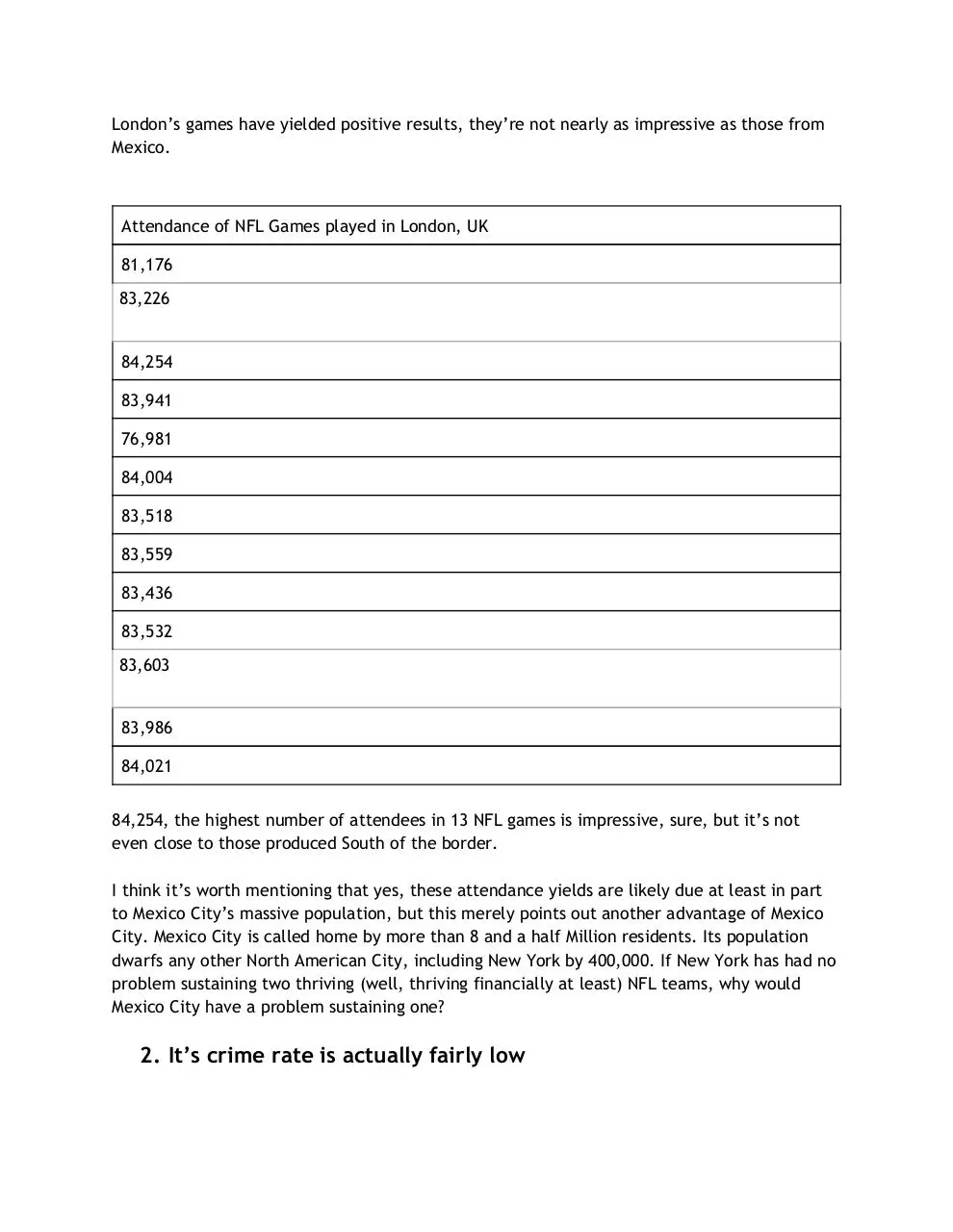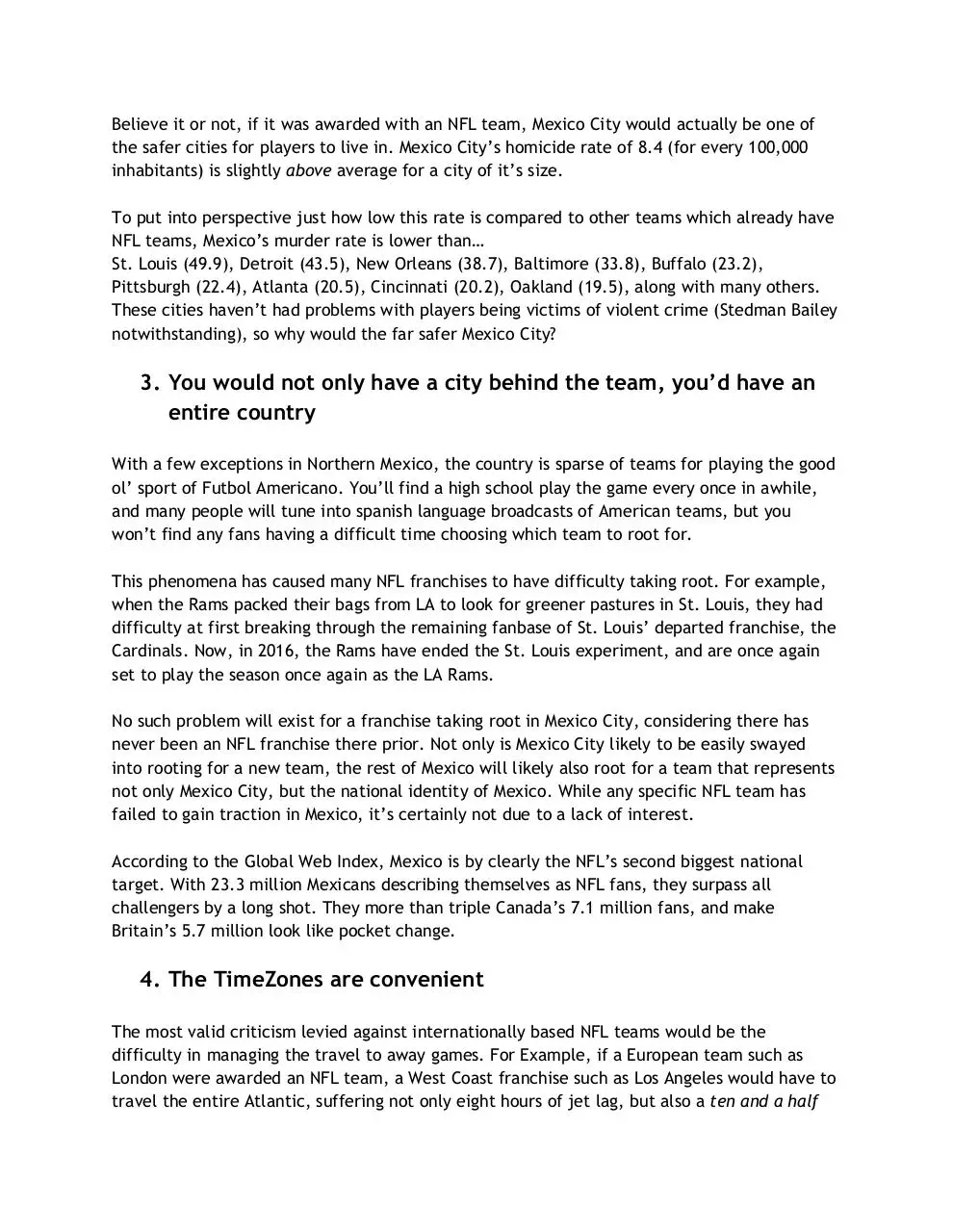SecondSample (PDF)
File information
This PDF 1.4 document has been generated by / Skia/PDF, and has been sent on pdf-archive.com on 13/02/2016 at 21:32, from IP address 173.95.x.x.
The current document download page has been viewed 358 times.
File size: 171.61 KB (4 pages).
Privacy: public file




File preview
Forget London, Mexico City is where the NFL
should look for international games.
Andy Nason
If I asked you right now what the most attended game in NFL history would be, what would
your answer be? Perhaps a Super Bowl or another heavily hyped matchup? Wrong! What if I
said it was not only a preseason game, but an
international
preseason game.
Yes, on August 15th, 1994, the NFL’s attendance record was
shattered
by a preseason game.
Whether it was due to the sports‐crazy culture of the city, the large stadium capacity, or the
desire to see a live NFL game (albeit, a preseason one) where any American football games
are fairly rare, the record stands to this day.
Yet the NFL continually ignores Mexico City and continually hyping up London, a city which
clearly is an inferior market for professional football.
1. Higher Ticket Sales and Market Size
When it comes to choosing a market, the first thing you must look at is attendance. Mexico
City has played host to one regular season game, a 2005 matchup between the San Francisco
Forty Niners and Arizona Cardinals. In true Mexico city fashion, the attending 103,467
attendants put the city’s name in the NFL record books, where it would stay until 2009. While
London’s games have yielded positive results, they’re not nearly as impressive as those from
Mexico.
Attendance of NFL Games played in London, UK
81,176
83,226
84,254
83,941
76,981
84,004
83,518
83,559
83,436
83,532
83,603
83,986
84,021
84,254, the highest number of attendees in 13 NFL games is impressive, sure, but it’s not
even close to those produced South of the border.
I think it’s worth mentioning that yes, these attendance yields are likely due at least in part
to Mexico City’s massive population, but this merely points out another advantage of Mexico
City. Mexico City is called home by more than 8 and a half Million residents. Its population
dwarfs any other North American City, including New York by 400,000. If New York has had no
problem sustaining two thriving (well, thriving financially at least) NFL teams, why would
Mexico City have a problem sustaining one?
2. It’s crime rate is actually fairly low
Believe it or not, if it was awarded with an NFL team, Mexico City would actually be one of
the safer cities for players to live in. Mexico City’s homicide rate of 8.4 (for every 100,000
inhabitants) is slightly
above
average for a city of it’s size.
To put into perspective just how low this rate is compared to other teams which already have
NFL teams, Mexico’s murder rate is lower than…
St. Louis (49.9), Detroit (43.5), New Orleans (38.7), Baltimore (33.8), Buffalo (23.2),
Pittsburgh (22.4), Atlanta (20.5), Cincinnati (20.2), Oakland (19.5), along with many others.
These cities haven’t had problems with players being victims of violent crime (Stedman Bailey
notwithstanding), so why would the far safer Mexico City?
3. You would not only have a city behind the team, you’d have an
entire country
With a few exceptions in Northern Mexico, the country is sparse of teams for playing the good
ol’ sport of Futbol Americano. You’ll find a high school play the game every once in awhile,
and many people will tune into spanish language broadcasts of American teams, but you
won’t find any fans having a difficult time choosing which team to root for.
This phenomena has caused many NFL franchises to have difficulty taking root. For example,
when the Rams packed their bags from LA to look for greener pastures in St. Louis, they had
difficulty at first breaking through the remaining fanbase of St. Louis’ departed franchise, the
Cardinals. Now, in 2016, the Rams have ended the St. Louis experiment, and are once again
set to play the season once again as the LA Rams.
No such problem will exist for a franchise taking root in Mexico City, considering there has
never been an NFL franchise there prior. Not only is Mexico City likely to be easily swayed
into rooting for a new team, the rest of Mexico will likely also root for a team that represents
not only Mexico City, but the national identity of Mexico. While any specific NFL team has
failed to gain traction in Mexico, it’s certainly not due to a lack of interest.
According to the Global Web Index, Mexico is by clearly the NFL’s second biggest national
target. With 23.3 million Mexicans describing themselves as NFL fans, they surpass all
challengers by a long shot. They more than triple Canada’s 7.1 million fans, and make
Britain’s 5.7 million look like pocket change.
4. The TimeZones are convenient
The most valid criticism levied against internationally based NFL teams would be the
difficulty in managing the travel to away games. For Example, if a European team such as
London were awarded an NFL team, a West Coast franchise such as Los Angeles would have to
travel the entire Atlantic, suffering not only eight hours of jet lag, but also a
ten and a half
hour
flight. Mexico City, however, is on the same Latitudinal plane as the USA, and resides in
the Central Time Zone. This would result in a Two Hour jet lag for West Coast teams, and One
for East Coast, obviously preferable over the long flight to the UK.
So why does the NFL continue to obsess over London while turning a blind eye to the far
preferable Mexico City? I’m not entirely sure, maybe it has something to do with an unfair
fear of Mexico? Maybe a lack of trust in the stability of Mexico’s economy, or an
overconfidence in the number of NFL fans in the UK. Whatever the reason, the league could
potentially make a huge mistake in investing in London rather than the far more preferable
location to the South
Download SecondSample
SecondSample.pdf (PDF, 171.61 KB)
Download PDF
Share this file on social networks
Link to this page
Permanent link
Use the permanent link to the download page to share your document on Facebook, Twitter, LinkedIn, or directly with a contact by e-Mail, Messenger, Whatsapp, Line..
Short link
Use the short link to share your document on Twitter or by text message (SMS)
HTML Code
Copy the following HTML code to share your document on a Website or Blog
QR Code to this page

This file has been shared publicly by a user of PDF Archive.
Document ID: 0000339799.